headrest RENAULT KANGOO 2012 X61 / 2.G Owners Manual
[x] Cancel search | Manufacturer: RENAULT, Model Year: 2012, Model line: KANGOO, Model: RENAULT KANGOO 2012 X61 / 2.GPages: 237, PDF Size: 8.62 MB
Page 7 of 237
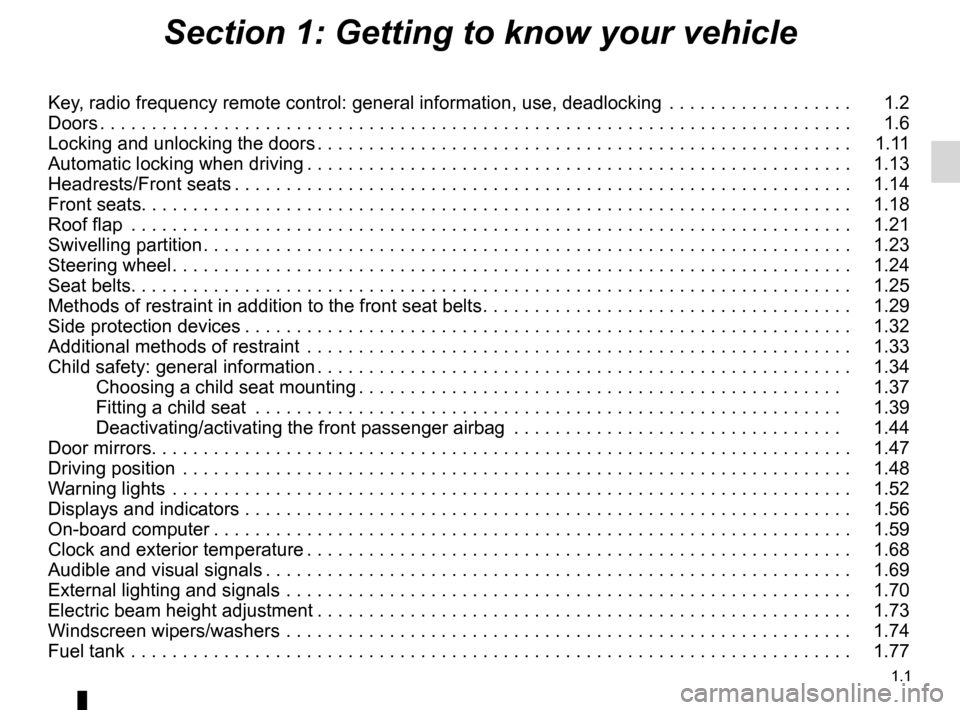
1.1
ENG_UD29618_11
Sommaire 1 (X61 - F61 - K61 - Renault)
ENG_NU_813-11_FK61_Renault_1
Section 1: Getting to know your vehicle
Key, radio frequency remote control: general information, use, deadlocking . . . . . . . . . . . . . . . . . . 1.2
Doors . . . . . . . . . . . . . . . . . . . . . . . . . . . . . . . . . . . . . . . . . . . . . . . . . . . . . . . . . . . . . . . . . . . . . . . . . 1.6
Locking and unlocking the doors . . . . . . . . . . . . . . . . . . . . . . . . . . . . . . . . . . . . . . . . . . . . . . . . . . . . 1.11
Automatic locking when driving . . . . . . . . . . . . . . . . . . . . . . . . . . . . . . . . . . . . . . . . . . . . . . . . . . . . . 1.13
Headrests/Front seats . . . . . . . . . . . . . . . . . . . . . . . . . . . . . . . . . . . . . . . . . . . . . . . . . . . . . . . . . . . . 1.14
Front seats . . . . . . . . . . . . . . . . . . . . . . . . . . . . . . . . . . . . . . . . . . . . . . . . . . . . . . . . . . . . . . . . . . . . . 1.18
Roof flap . . . . . . . . . . . . . . . . . . . . . . . . . . . . . . . . . . . . . . . . . . . . . . . . . . . . . . . . . . . . . . . . . . . . . . 1.21
Swivelling partition . . . . . . . . . . . . . . . . . . . . . . . . . . . . . . . . . . . . . . . . . . . . . . . . . . . . . . . . . . . . . . . 1.23
Steering wheel . . . . . . . . . . . . . . . . . . . . . . . . . . . . . . . . . . . . . . . . . . . . . . . . . . . . . . . . . . . . . . . . . . 1.24
Seat belts . . . . . . . . . . . . . . . . . . . . . . . . . . . . . . . . . . . . . . . . . . . . . . . . . . . . . . . . . . . . . . . . . . . . . . 1.25
Methods of restraint in addition to the front seat belts . . . . . . . . . . . . . . . . . . . . . . . . . . . . . . . . . . . . 1.29
Side protection devices . . . . . . . . . . . . . . . . . . . . . . . . . . . . . . . . . . . . . . . . . . . . . . . . . . . . . . . . . . . 1.32
Additional methods of restraint . . . . . . . . . . . . . . . . . . . . . . . . . . . . . . . . . . . . . . . . . . . . . . . . . . . . . 1.33
Child safety: general information . . . . . . . . . . . . . . . . . . . . . . . . . . . . . . . . . . . . . . . . . . . . . . . . . . . . 1.34
Choosing a child seat mounting . . . . . . . . . . . . . . . . . . . . . . . . . . . . . . . . . . . . . . . . . . . . . . . 1.37
Fitting a child seat . . . . . . . . . . . . . . . . . . . . . . . . . . . . . . . . . . . . . . . . . . . . . . . . . . . . . . . . . 1.39
Deactivating/activating the front passenger airbag . . . . . . . . . . . . . . . . . . . . . . . . . . . . . . . . 1.44
Door mirrors . . . . . . . . . . . . . . . . . . . . . . . . . . . . . . . . . . . . . . . . . . . . . . . . . . . . . . . . . . . . . . . . . . . . 1.47
Driving position . . . . . . . . . . . . . . . . . . . . . . . . . . . . . . . . . . . . . . . . . . . . . . . . . . . . . . . . . . . . . . . . . 1.48
Warning lights . . . . . . . . . . . . . . . . . . . . . . . . . . . . . . . . . . . . . . . . . . . . . . . . . . . . . . . . . . . . . . . . . . 1.52
Displays and indicators . . . . . . . . . . . . . . . . . . . . . . . . . . . . . . . . . . . . . . . . . . . . . . . . . . . . . . . . . . . 1.56
On-board computer . . . . . . . . . . . . . . . . . . . . . . . . . . . . . . . . . . . . . . . . . . . . . . . . . . . . . . . . . . . . . . 1.59
Clock and exterior temperature . . . . . . . . . . . . . . . . . . . . . . . . . . . . . . . . . . . . . . . . . . . . . . . . . . . . . 1.68
Audible and visual signals . . . . . . . . . . . . . . . . . . . . . . . . . . . . . . . . . . . . . . . . . . . . . . . . . . . . . . . . . 1.69
External lighting and signals . . . . . . . . . . . . . . . . . . . . . . . . . . . . . . . . . . . . . . . . . . . . . . . . . . . . . . . 1.70
Electric beam height adjustment . . . . . . . . . . . . . . . . . . . . . . . . . . . . . . . . . . . . . . . . . . . . . . . . . . . . 1.73
Windscreen wipers/washers . . . . . . . . . . . . . . . . . . . . . . . . . . . . . . . . . . . . . . . . . . . . . . . . . . . . . . . 1.74
Fuel tank . . . . . . . . . . . . . . . . . . . . . . . . . . . . . . . . . . . . . . . . . . . . . . . . . . . . . . . . . . . . . . . . . . . . . . 1.77
Page 20 of 237
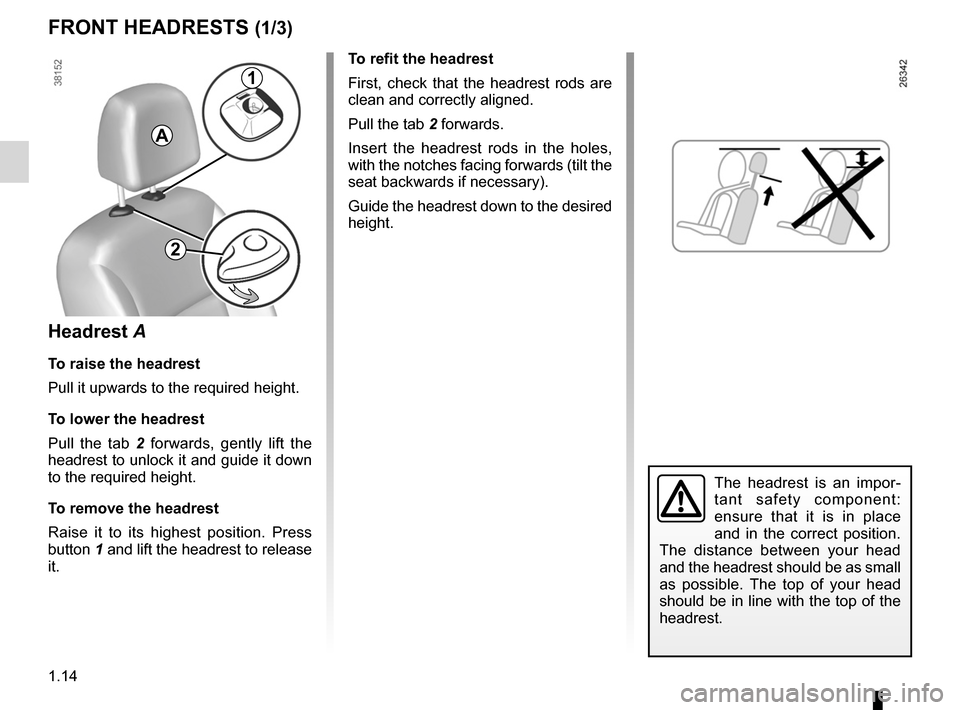
headrest................................................ (up to the end of the DU)
1.14
ENG_UD29319_4
Appuis-tête avant (X61 - F61 - K61 - Renault)
ENG_NU_813-11_FK61_Renault_1
Jaune NoirNoir texte
Headrests/Front seats
FRONT HeADReSTS (1/3)
To refit the headrest
First, check that the headrest rods are
clean and correctly aligned.
Pull the tab 2 forwards.
Insert the headrest rods in the holes,
with the notches facing forwards (tilt the
seat backwards if necessary).
Guide the headrest down to the desired
height.
Headrest A
To raise the headrest
Pull it upwards to the required height.
To lower the headrest
Pull the tab 2 forwards, gently lift the
headrest to unlock it and guide it down
to the required height.
To remove the headrest
Raise it to its highest position. Press
button 1 and lift the headrest to release
it.
A
The headrest is an impor -
tant safety component:
ensure that it is in place
and in the correct position.
The distance between your head
and the headrest should be as small
as possible. The top of your head
should be in line with the top of the
headrest.
1
2
Page 21 of 237

JauneNoirNoir texte
1.15
ENG_UD29319_4
Appuis-tête avant (X61 - F61 - K61 - Renault)
ENG_NU_813-11_FK61_Renault_1
To remove the headrest
Raise it to its highest position. Press
button 4 and lift the headrest to release
it.
Note: when the headrest is removed,
take care not to change the positions
of the rods.
To refit the headrest
If the setting of the rods has been al -
tered, pull them fully upwards. Take
care to ensure they are clean and cor-
rectly aligned and, if there are any prob-
lems, check that the notches are facing
forwards.
Insert the headrest rods into the holes
(tilt the seatback backwards if neces -
sary).
Lower the headrest until it locks, press
button 3 and lower the headrest as far
as possible.
FRONT HeADReSTS (2/3)
Headrest B
To raise the headrest
Pull it upwards to the required height.
To lower the headrest
Press button 3 and guide the headrest
down to the desired height.
The headrest is an impor -
tant safety component:
ensure that it is in place
and in the correct position.
The distance between your head
and the headrest should be as small
as possible. The top of your head
should be in line with the top of the
headrest.
3
B
4
Page 22 of 237
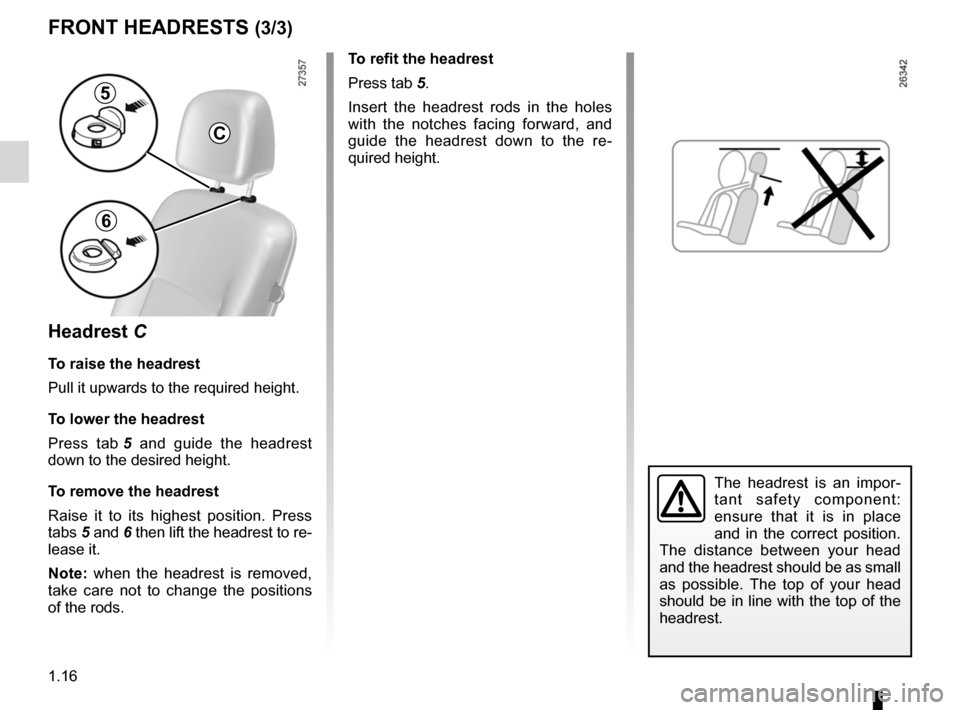
1.16
ENG_UD29319_4
Appuis-tête avant (X61 - F61 - K61 - Renault)
ENG_NU_813-11_FK61_Renault_1
FRONT HeADReSTS (3/3)
Headrest C
To raise the headrest
Pull it upwards to the required height.
To lower the headrest
Press tab 5 and guide the headrest
down to the desired height.
To remove the headrest
Raise it to its highest position. Press
tabs 5 and 6 then lift the headrest to re-
lease it.
Note: when the headrest is removed,
take care not to change the positions
of the rods.
To refit the headrest
Press tab 5.
Insert the headrest rods in the holes
with the notches facing forward, and
guide the headrest down to the re -
quired height.
The headrest is an impor -
tant safety component:
ensure that it is in place
and in the correct position.
The distance between your head
and the headrest should be as small
as possible. The top of your head
should be in line with the top of the
headrest.
5
6
C
Page 23 of 237

headrest................................................ (up to the end of the DU)
1.17
ENG_UD21411_3
Appuis-tête arrière (X61 - F61 - K61 - Renault)
ENG_NU_813-11_FK61_Renault_1
The headrest is a safety
component; check that it is
fitted and in the correct po-
sition.
Storage position 2Pull it towards you and lower it com -
pletely.
When the headrest is fully lowered, it
is in the storage position: do not use
this position when someone is sitting in
the rear seats.To raise itSlide it to the required height.
To lower itPull it towards you and slide it to the re-
quired height.
To remove it
Raise the headrest then press tabs 1 to
release it.
To refit itPress tab 1 and insert the rods into the
holes, with the notches facing forwards.
ReAR HeADReSTS
12
Child’s convertible headrest
If fitted to the vehicle, the child head -
rest and booster cushion can only be
installed on the rear side seats.
For fitting and use, refer to the equip -
ment instructions.
Page 25 of 237
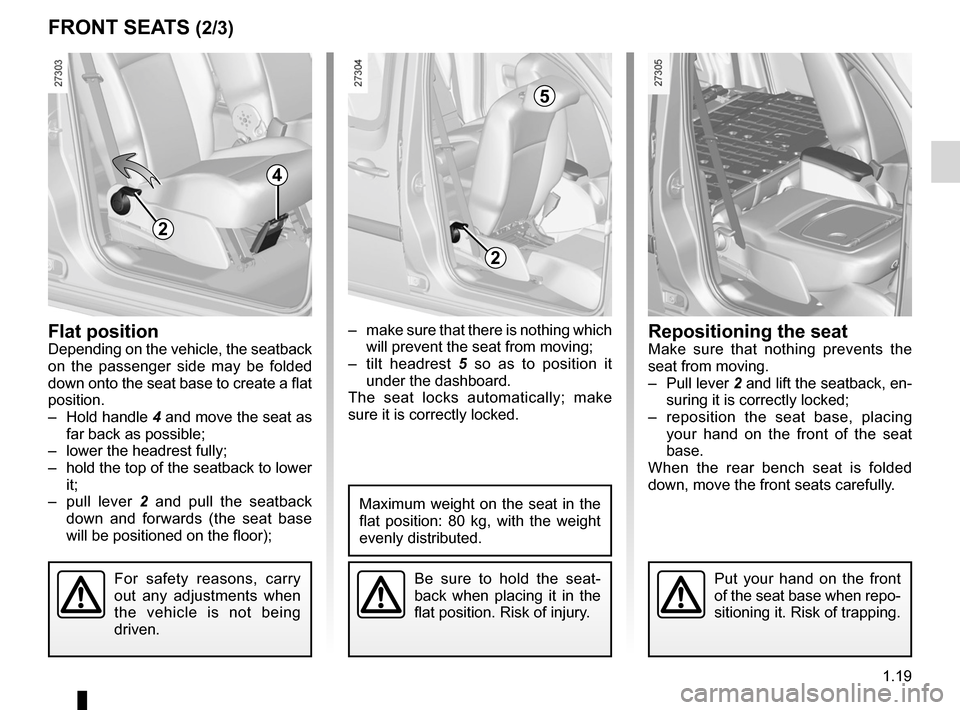
JauneNoirNoir texte
1.19
ENG_UD21409_6
Sièges avant (X61 - F61 - K61 - Renault)
ENG_NU_813-11_FK61_Renault_1
– make sure that there is nothing which
will prevent the seat from moving;
– tilt headrest 5 so as to position it
under the dashboard.
The seat locks automatically; make
sure it is correctly locked.Flat positionDepending on the vehicle, the seatback
on the passenger side may be folded
down onto the seat base to create a flat
position.
– Hold handle 4 and move the seat as
far back as possible;
– lower the headrest fully;
– hold the top of the seatback to lower
it;
– pull lever 2 and pull the seatback
down and forwards (the seat base
will be positioned on the floor);
Be sure to hold the seat -
back when placing it in the
flat position. Risk of injury.
Maximum weight on the seat in the
flat position: 80 kg, with the weight
evenly distributed.
FRONT SeATS (2/3)
4
2
2
5
For safety reasons, carry
out any adjustments when
the vehicle is not being
driven.Put your hand on the front
of the seat base when repo-
sitioning it. Risk of trapping.
Repositioning the seatMake sure that nothing prevents the
seat from moving.
– Pull lever 2 and lift the seatback, en-
suring it is correctly locked;
– reposition the seat base, placing
your hand on the front of the seat
base.
When the rear bench seat is folded
down, move the front seats carefully.
Page 29 of 237
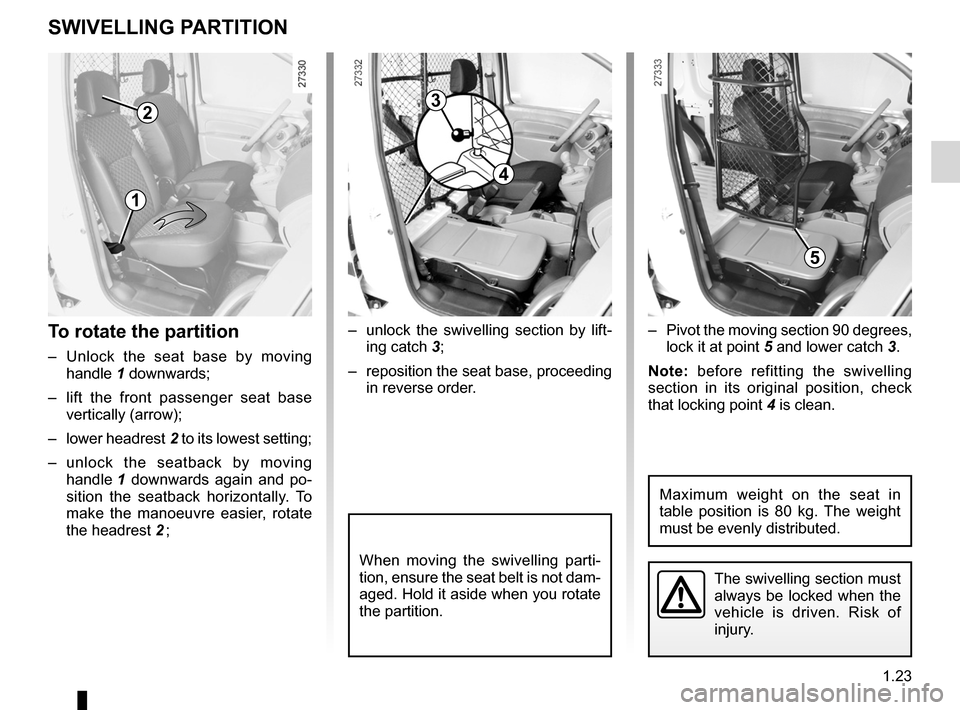
partition ................................................. (up to the end of the DU)
1.23
ENG_UD21408_2
Cloison de séparation (X61 - F61 - K61 - Renault)
ENG_NU_813-11_FK61_Renault_1
To rotate the partition
– Unlock the seat base by moving
handle 1 downwards;
– lift the front passenger seat base
vertically (arrow);
– lower headrest 2 to its lowest setting;
– unlock the seatback by moving
handle 1 downwards again and po -
sition the seatback horizontally. To
make the manoeuvre easier, rotate
the headrest 2 ; –
Pivot the moving section 90 degrees,
lock it at point 5 and lower catch 3.
Note: before refitting the swivelling
section in its original position, check
that locking point 4 is clean.
–
unlock the swivelling section by lift -
ing catch 3;
– reposition the seat base, proceeding
in reverse order.
Swivelling partition
The swivelling section must
always be locked when the
vehicle is driven. Risk of
injury.
SWIveLLING p ARTITION
When moving the swivelling parti -
tion, ensure the seat belt is not dam-
aged. Hold it aside when you rotate
the partition.
1
23
4
5
Maximum weight on the seat in
table position is 80 kg. The weight
must be evenly distributed.
Page 31 of 237
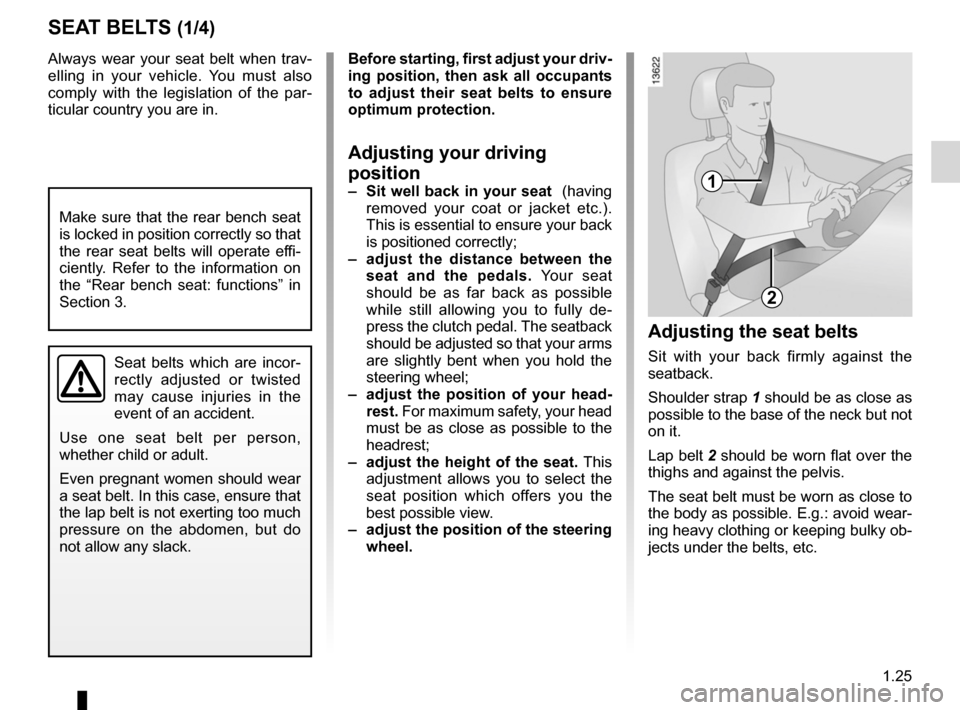
seat belts .............................................. (up to the end of the DU)
driving position settings ........................................... (up to the end of the DU)
1.25
ENG_UD25776_6
Ceintures de sécurité (X61 - F61 - K61 - Renault)
ENG_NU_813-11_FK61_Renault_1
Seat belts
SeAT BeLTS (1/4)
Adjusting the seat belts
Sit with your back firmly against the
seatback.
Shoulder strap 1 should be as close as
possible to the base of the neck but not
on it.
Lap belt 2 should be worn flat over the
thighs and against the pelvis.
The seat belt must be worn as close to
the body as possible. E.g.: avoid wear-
ing heavy clothing or keeping bulky ob-
jects under the belts, etc.
1
2
Always wear your seat belt when trav-
elling in your vehicle. You must also
comply with the legislation of the par-
ticular country you are in.
Seat belts which are incor -
rectly adjusted or twisted
may cause injuries in the
event of an accident.
Use one seat belt per person,
whether child or adult.
Even pregnant women should wear
a seat belt. In this case, ensure that
the lap belt is not exerting too much
pressure on the abdomen, but do
not allow any slack.
Before starting, first adjust your driv-
ing position, then ask all occupants
to adjust their seat belts to ensure
optimum protection.
Adjusting your driving
position
– Sit well back in your seat (having
removed your coat or jacket etc.).
This is essential to ensure your back
is positioned correctly;
– adjust the distance between the
seat and the pedals. Your seat
should be as far back as possible
while still allowing you to fully de -
press the clutch pedal. The seatback
should be adjusted so that your arms
are slightly bent when you hold the
steering wheel;
– adjust the position of your head -
rest. For maximum safety, your head
must be as close as possible to the
headrest;
– adjust the height of the seat. This
adjustment allows you to select the
seat position which offers you the
best possible view.
– adjust the position of the steering
wheel.
Make sure that the rear bench seat
is locked in position correctly so that
the rear seat belts will operate effi -
ciently. Refer to the information on
the “Rear bench seat: functions” in
Section 3.
Page 45 of 237
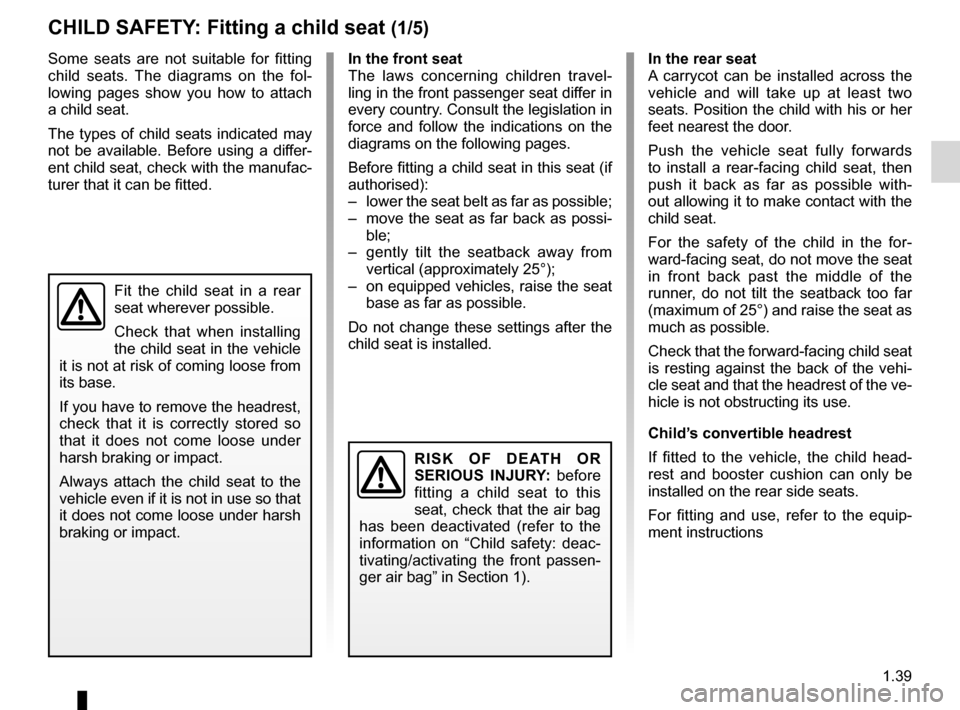
child seats............................................. (up to the end of the DU)
Isofix ..................................................... (up to the end of the DU)
child safety ............................................ (up to the end of the DU)
child restraint/seat ................................ (up to the end of the DU)
transporting children ............................. (up to the end of the DU)
child restraint/seat ................................ (up to the end of the DU)
1.39
ENG_UD22997_5
Sécurité enfants : installation du siège enfant (X61 - F61 - K61 - Renault)
ENG_NU_813-11_FK61_Renault_1
Fitting a child seat
Some seats are not suitable for fitting
child seats. The diagrams on the fol -
lowing pages show you how to attach
a child seat.
The types of child seats indicated may
not be available. Before using a differ-
ent child seat, check with the manufac-
turer that it can be fitted.
CHILD SAFeTy: Fitting a child seat (1/5)
In the rear seat
A carrycot can be installed across the
vehicle and will take up at least two
seats. Position the child with his or her
feet nearest the door.
Push the vehicle seat fully forwards
to install a rear-facing child seat, then
push it back as far as possible with -
out allowing it to make contact with the
child seat.
For the safety of the child in the for -
ward-facing seat, do not move the seat
in front back past the middle of the
runner, do not tilt the seatback too far
(maximum of 25°) and raise the seat as
much as possible.
Check that the forward-facing child seat
is resting against the back of the vehi-
cle seat and that the headrest of the ve-
hicle is not obstructing its use.
Child’s convertible headrest
If fitted to the vehicle, the child head -
rest and booster cushion can only be
installed on the rear side seats.
For fitting and use, refer to the equip -
ment instructions
In the front seat
The laws concerning children travel
-
ling in the front passenger seat differ in
every country. Consult the legislation in
force and follow the indications on the
diagrams on the following pages.
Before fitting a child seat in this seat (if
authorised):
– lower the seat belt as far as possible;
– move the seat as far back as possi-
ble;
– gently tilt the seatback away from
vertical (approximately 25°);
– on equipped vehicles, raise the seat
base as far as possible.
Do not change these settings after the
child seat is installed.
R I S K O F D eAT H O R
S eRIOUS INJUR y: before
fitting a child seat to this
seat, check that the air bag
has been deactivated (refer to the
information on “Child safety: deac -
tivating/activating the front passen -
ger air bag” in Section 1).
Fit the child seat in a rear
seat wherever possible.
Check that when installing
the child seat in the vehicle
it is not at risk of coming loose from
its base.
If you have to remove the headrest,
check that it is correctly stored so
that it does not come loose under
harsh braking or impact.
Always attach the child seat to the
vehicle even if it is not in use so that
it does not come loose under harsh
braking or impact.
Page 49 of 237
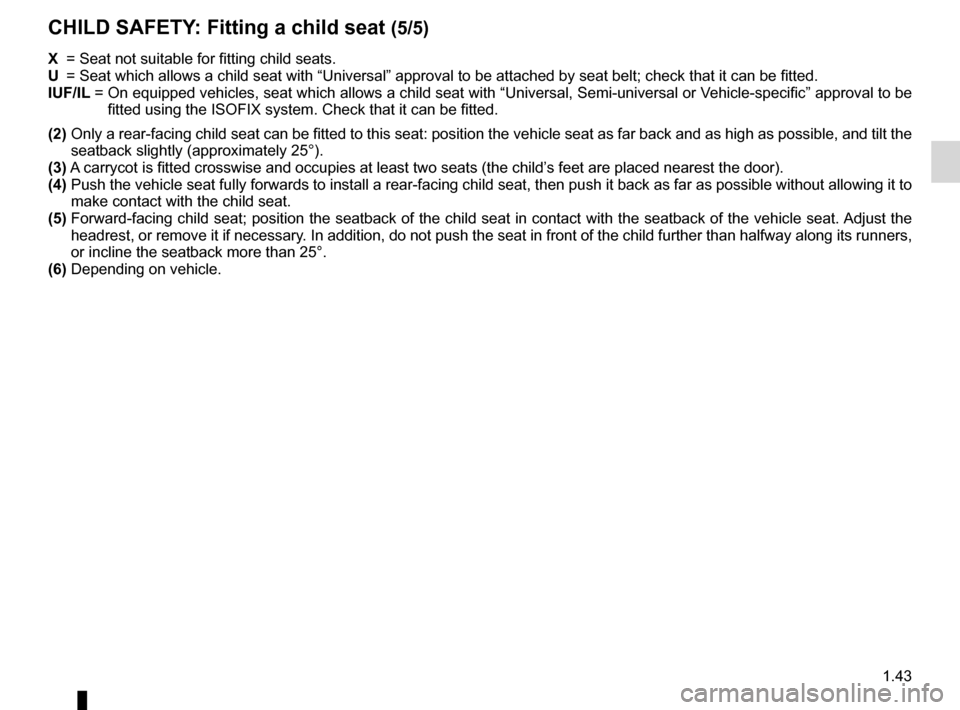
JauneNoirNoir texte
1.43
ENG_UD22997_5
Sécurité enfants : installation du siège enfant (X61 - F61 - K61 - Renault)
ENG_NU_813-11_FK61_Renault_1
X = Seat not suitable for fitting child seats.
U = Seat which allows a child seat with “Universal” approval to be attached by seat belt; check that it can be fitted.
IUF/IL = On equipped vehicles, seat which allows a child seat with “Universal, Semi-universal or Vehicle-specific” approval to be
fitted using the ISOFIX system. Check that it can be fitted.
(2) Only a rear-facing child seat can be fitted to this seat: position the vehicle seat as far back and as high as possible, and tilt the
seatback slightly (approximately 25°).
(3) A carrycot is fitted crosswise and occupies at least two seats (the child’s feet are placed nearest the door).
(4) Push the vehicle seat fully forwards to install a rear-facing child seat, then push it back as far as possible without allowing it to
make contact with the child seat.
(5) Forward-facing child seat; position the seatback of the child seat in contact with the seatback of the vehicle seat. Adjust the
headrest, or remove it if necessary. In addition, do not push the seat in front of the child further than halfway along its runners,
or incline the seatback more than 25°.
(6) Depending on vehicle.
CHILD SAFeTy: Fitting a child seat (5/5)